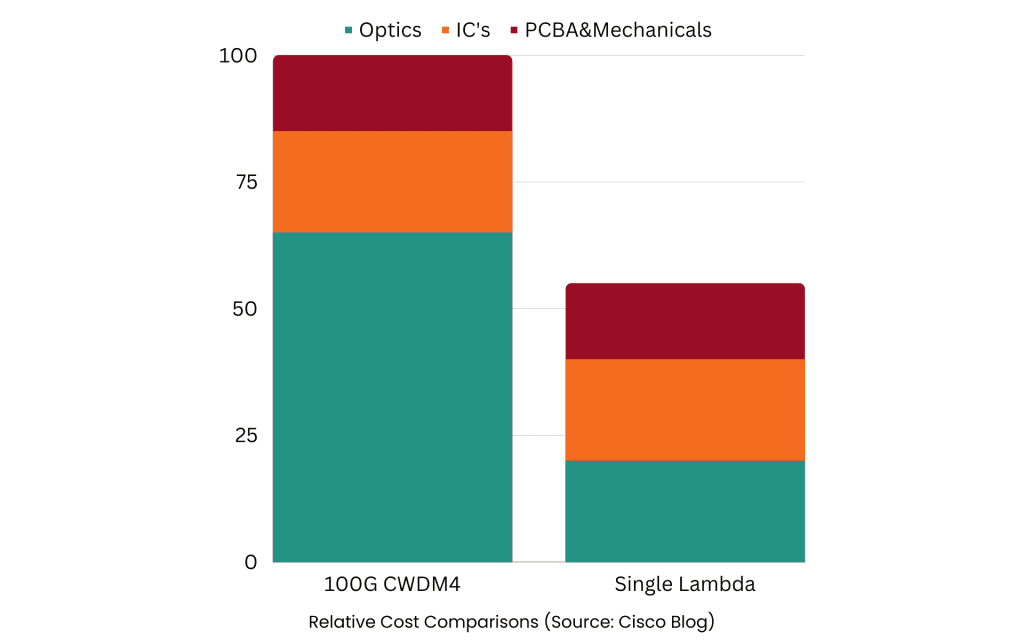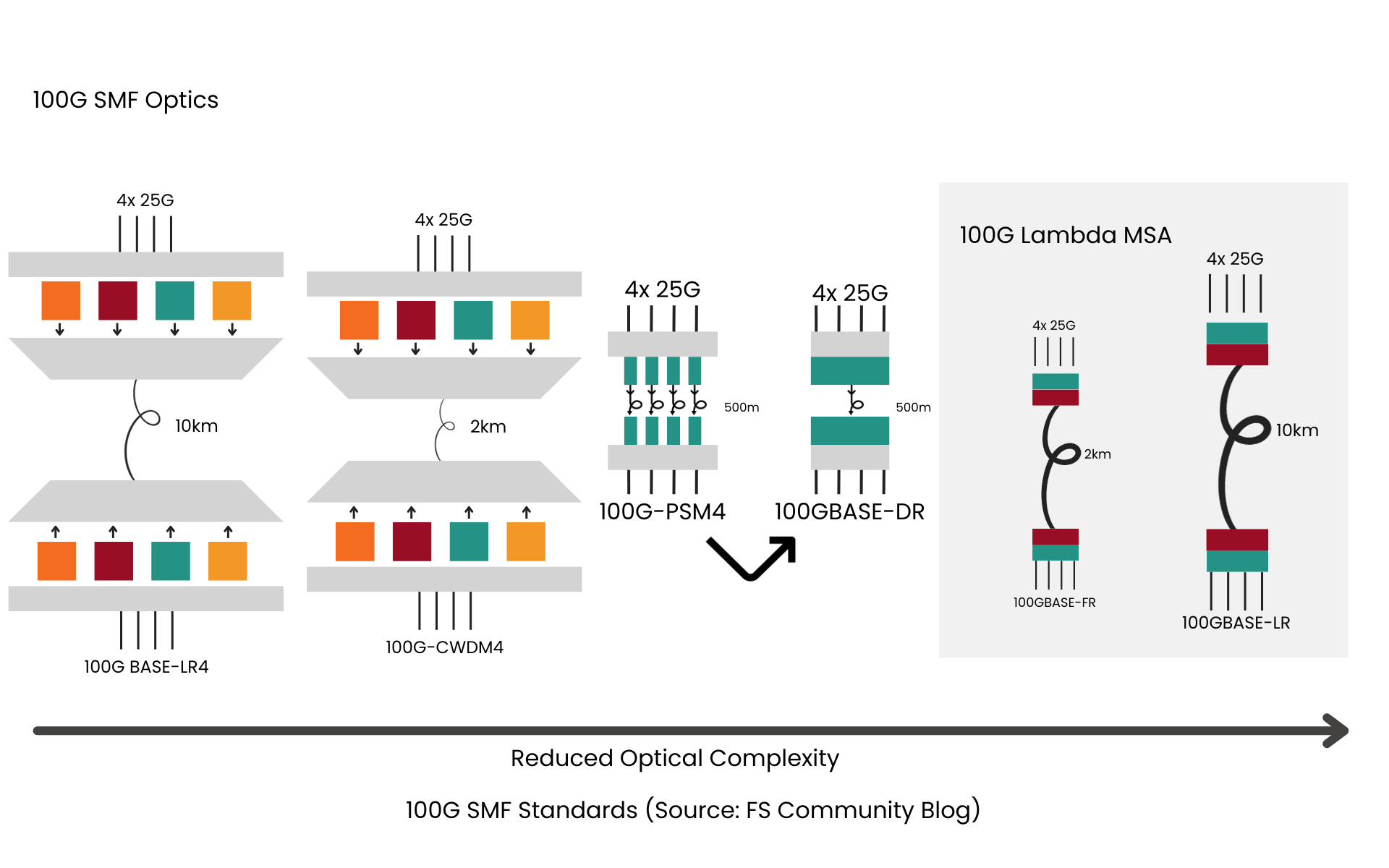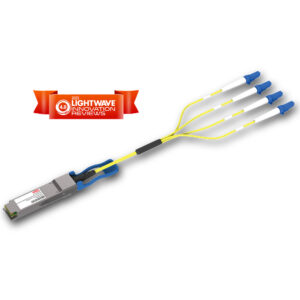From streaming high-definition content to supporting the burgeoning Internet of Things (IoT) ecosystem and powering next-generation applications, networks are under constant pressure to perform at unprecedented levels. How can data centers balance escalating bandwidth requirements and cost-effectiveness? And is future compatibility too much to ask?
Enter 100G single lambda optics, a technology revolutionizing network connectivity with high data rates, low latency, low power consumption and low costs.
What is 100G Single Lambda?

100G single lambda is an approach to optical communication that leverages a single wavelength of light to achieve data speeds of up to 100 gigabits per second (Gb/s). But what sets single lambda 100G optics apart from other optical technologies?
QSFP28 optical transceivers are typically used to support networks. In this case, achieving data rates of up to 100 Gb/s requires the transmission of 4x 25Gb/s Non-return to Zero (NRZ) signals at different wavelengths. Each signal carries a portion of the data in what is known as wavelength division multiplexing (WDM). While effective, this solution adds complexity as it requires precise coordination of multiple wavelengths and components.
100G single lambda simplifies by using a single wavelength (instead of four) to transmit data at 100 Gb/s. This streamlined design reduces the need for complex equipment and simplifies network management, resulting in more efficient and cost-effective solutions.
How 100G single lambda optics reduce data center costs
One of the primary ways 100G Single Lambda optics contribute to cost reduction is by simpler structure. IEEE and 100G Lambda MSA, the industry consortium that developed the optical interface specifications for 100G and 400G, have recognized that a single optical fiber operating at 100Gb/s can be up to 40% less expensive than conventional methods. (Or, that the transition from 4 to 1 wavelengths, or lambda, is reduced by more than 40%.)

Traditional data center networks often rely on complex, multi-wavelength systems to achieve high data transfer rates. These intricate setups require a multitude of components, including Clock Data Recovery (CDR), multiplexers, demultiplexers, multiple lasers and optical modules, increasing both capital and operational expenditures.
In contrast, 100G Single Lambda achieves remarkable data speeds using just one signal, streamlining the network infrastructure.
- Transmitter: a DSP, CDR, Laser Driver (LD), and laser
- Receiver: a DSP, CDR, Trans-Impedance Amplifier (TIA) + Linear Amplifier (LA), and PIN photodiode
Additional cost savings are derived from a much longer transmission distance. The 100G Lambda MSA extended the reach of single lambda optics to 2km. Used as a replacement for 100G QSFP28 modules which have a limit of 500m, single lambda requires less infrastructure to reach the same distance.
Altogether, the streamlined 100G single lambda translates into reduced hardware requirements, fewer points of failure, and simplified maintenance, all of which contribute to lower initial capital expenditures and operating costs.
Read the 100G QSFP28 Single Lambda Transceiver Benefits >
The network upgrade advantage of 100G Single Lambda
Network operators can stack multiple 100G single lambda modules together to effortlessly boost network capacity and meet the evolving requirements of future applications without requiring an extensive overhaul of their existing infrastructure.
400G QSFP-DD optical transceivers stack 4x 100G PAM4 lanes to create a lower-cost path to 400G. The PAM4 signaling technique they use makes them backwards compatible with 100G single lambda cables. Using 100G single lambda transceivers, 400G device ports can be easily connected using 100G breakouts.
If a network has devices with 100G QSFP28 ports, it can be upgraded site-by-site to 400G and still connect to the remaining 100G without sacrificing port bandwidth. Downtime is minimized, upgrades can roll out gradually and budgets are not hit with a full replacement cost.

Several developments, including PAM8 signaling, are expected in the coming years as more applications demand high data rates, low power consumption and low latency.
Applications that benefit from 100G Single Lambda’s high speed at low cost
Single lambda optics leverage advanced PAM4 modulation techniques to allow super-fast data transmission of up to 100 gigabits per second (Gb/s). Their lightning-fast data transmission, low costs, low power consumption and low latency makes 100G single lambda ideal for swift and seamless applications such as financial services, market trading, high speed computing, autonomous vehicles and aeronautical/military.
- Data centers and cloud computing. Single lambda 100G optics are an optimal solution for data centers where expansion and upgrades are constant. They provide the much-needed scalability and flexibility for long-haul and metropolitan networks, enhancing network efficiency while concurrently reducing power consumption, space requirements, capital expenditures (CAPEX), and operational expenses (OPEX). As noted earlier, a huge advantage for data centers is the seamless transition 100G single lambda offers from 100G and 400G connections in both directions.
- 5G mobile networks. Advanced cellular technologies like 5G require high speed and low-latency connectivity to support real-time services such as live event streaming, AR/VR, autonomous vehicles, online gaming, and telemedicine. The 5G model, with a front and back haul split in the transport network and extremely high data rates, takes advantage of the high bandwidth, speed, and reliability of single-λ 100G (and 400G) optics. Single lambda optics are also expected to play a critical role in the development of next-generation wireless networks like 6G.
- Internet of Things (IoT). Meeting the demands of real-time services and supporting the growing number of connected devices and cloud servers requires ultra-fast, low latency and reliable data transmission. Single lambda 100G optics can support high density IoT devices within smart cities and long-haul links in rural areas.
- High performance computing (HPC). HPC systems demand lightning-fast data transfers and low-latency connectivity to crunch vast datasets and execute complex simulations. Single lambda optics shine by providing exceptional bandwidth capabilities, enabling HPC clusters to efficiently exchange data among nodes, storage systems, and external networks. Their single-wavelength, high-speed transmission not only accelerates computational tasks but also simplifies network architecture and optimizes power consumption.
- Telecommunications and internet service providers (ISPs). Whether in the backbone of global telecommunications networks or within data centers, 100G single lambda optics empower ISPs to deliver faster and more reliable internet services, ultimately enhancing user experiences and ensuring networks are well-equipped to support the ever-evolving digital landscape.
Vitex’s expert engineers specialize in solving optical problems with off-the-shelf and customized optical solutions. Contact us today for inquiries or quotes on 100G single lambda products.
Questions?
We’ll connect you with the right solution.


